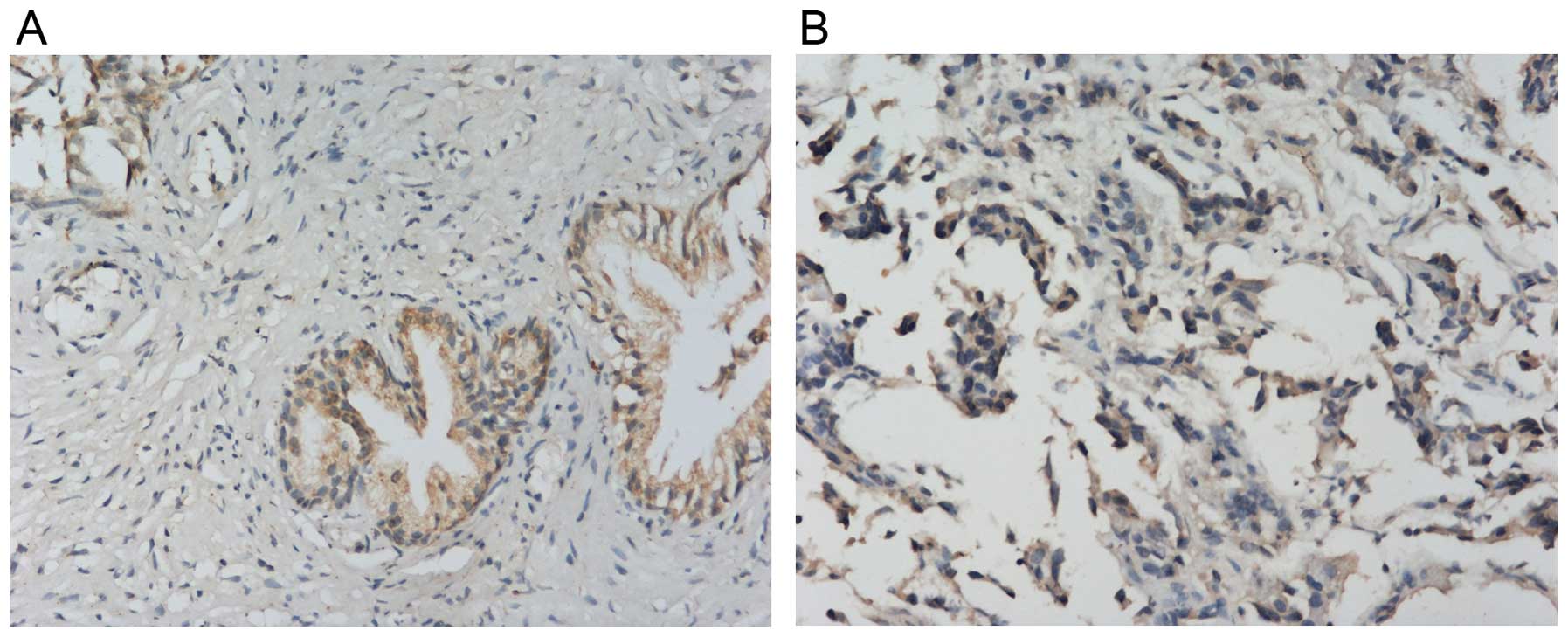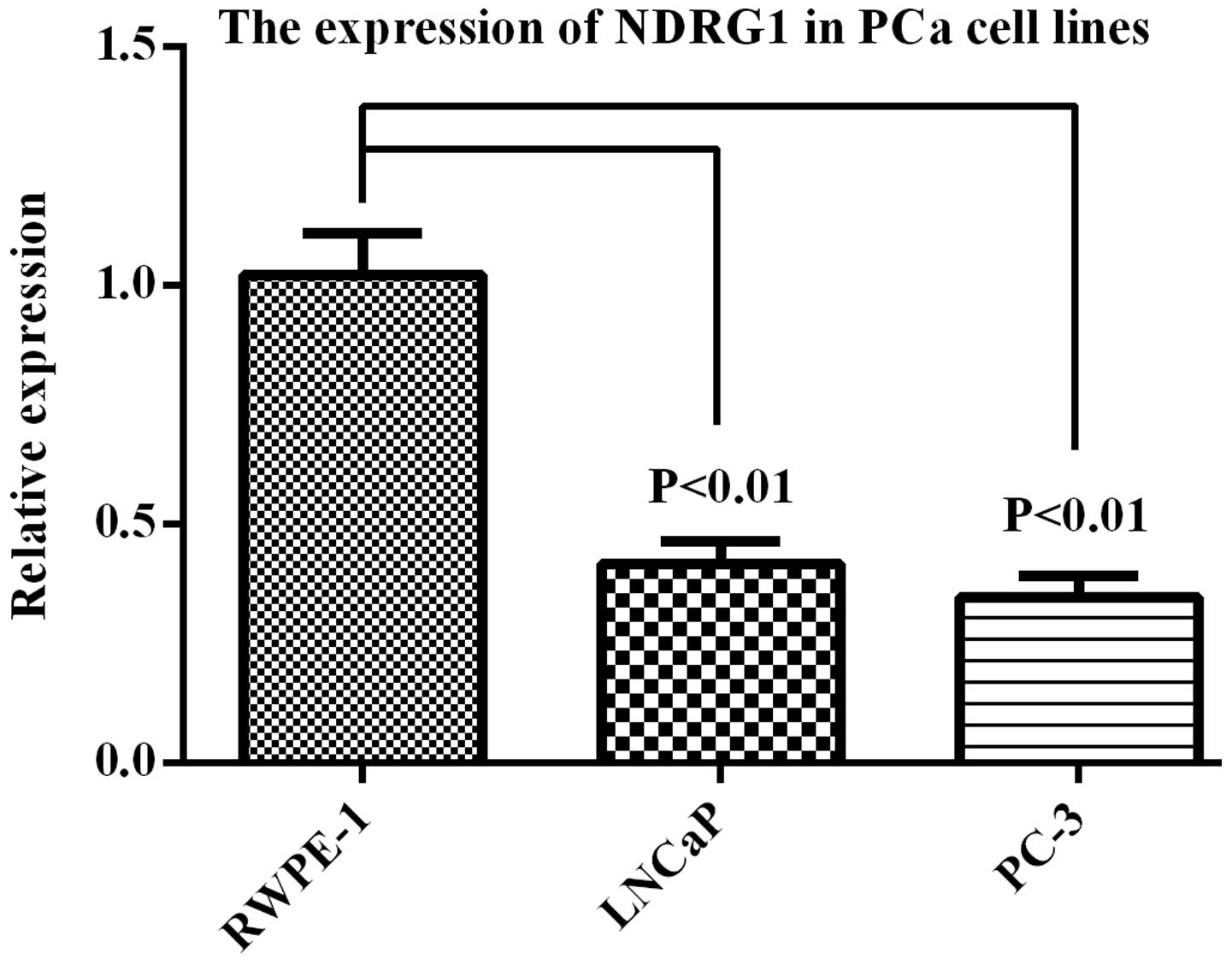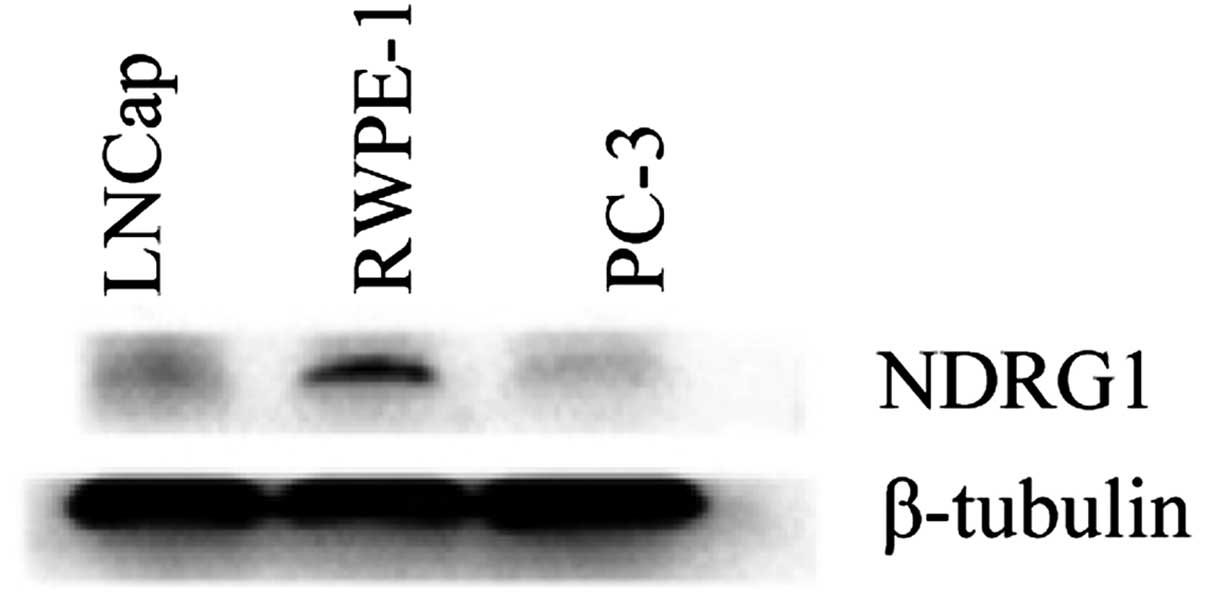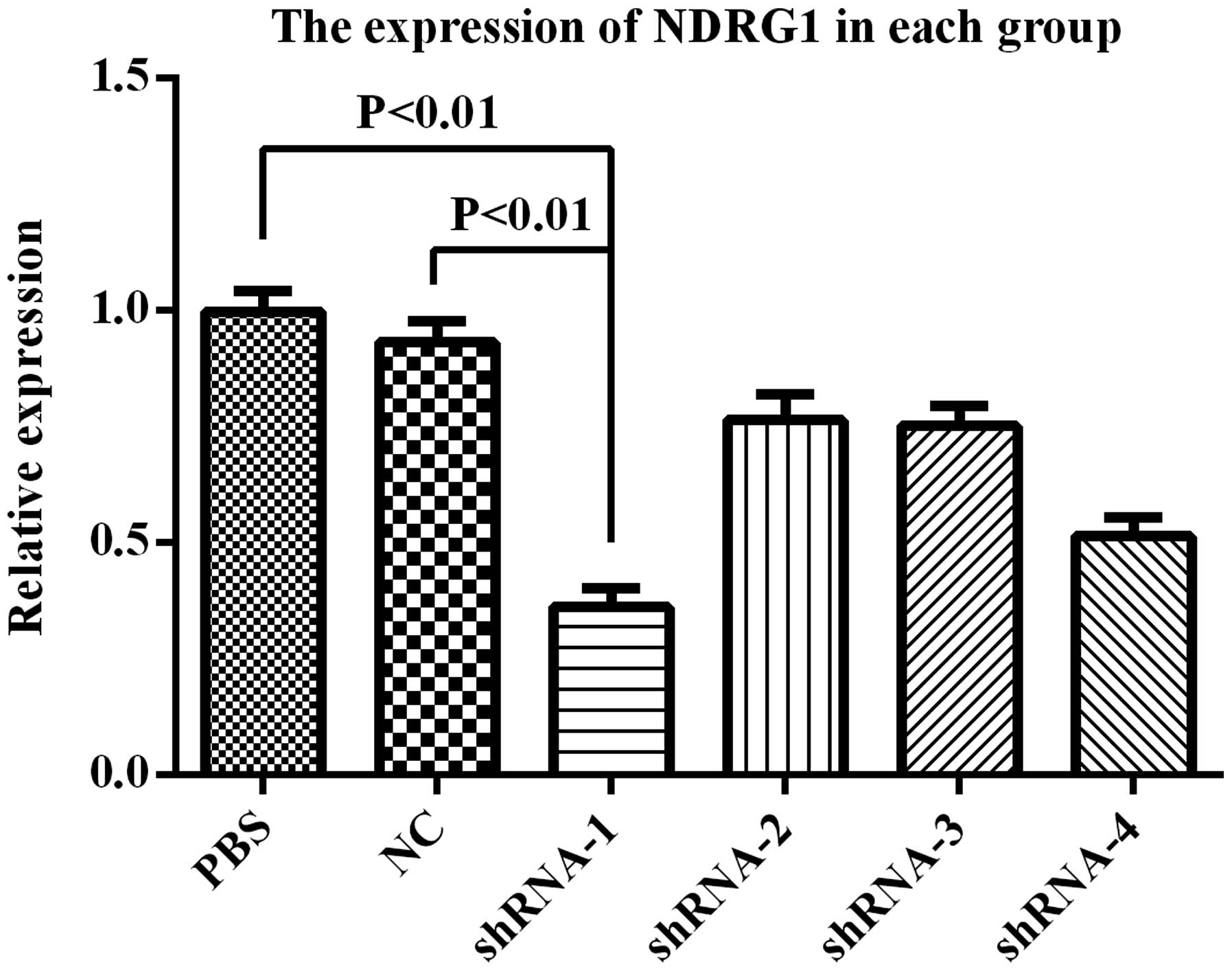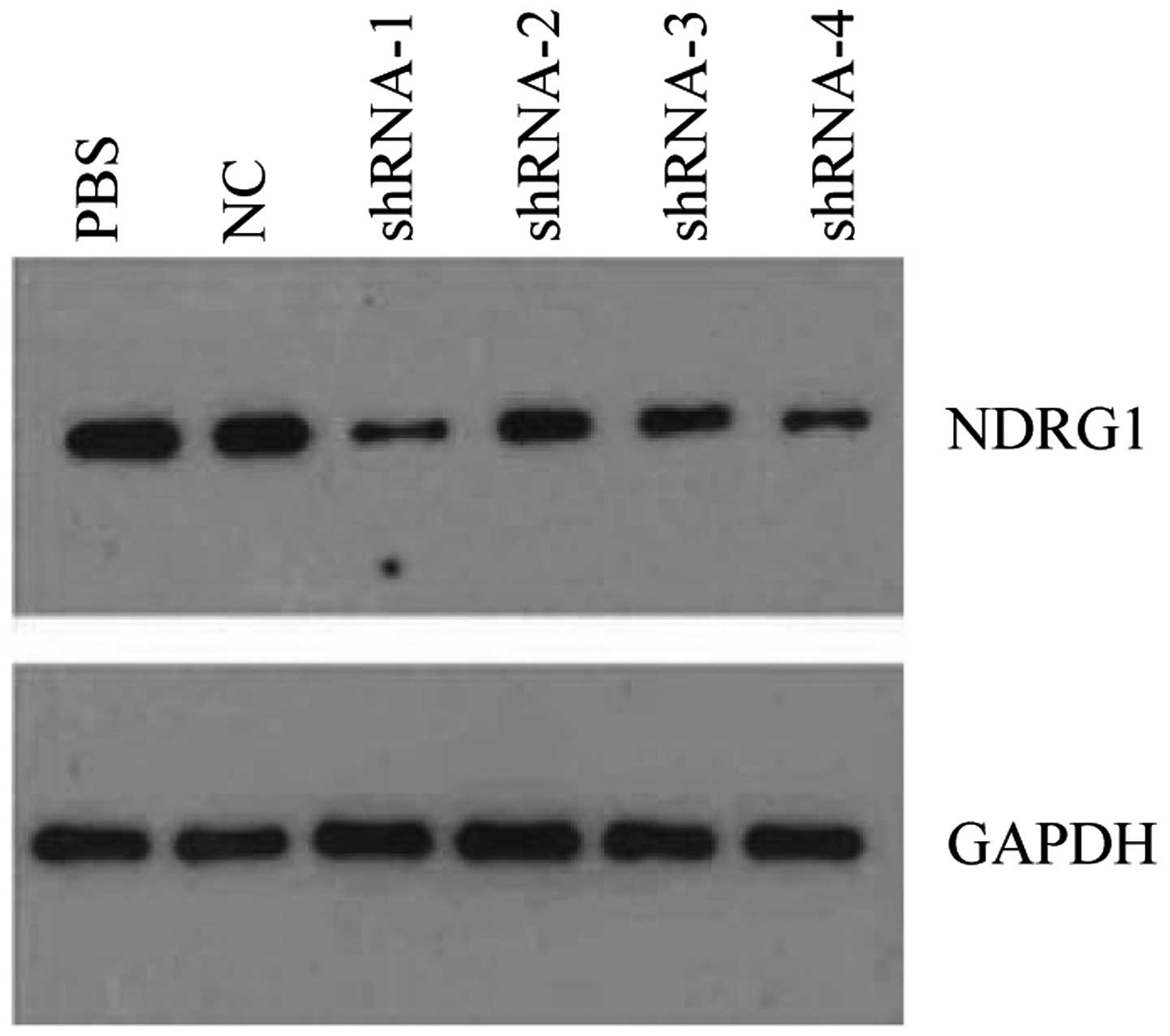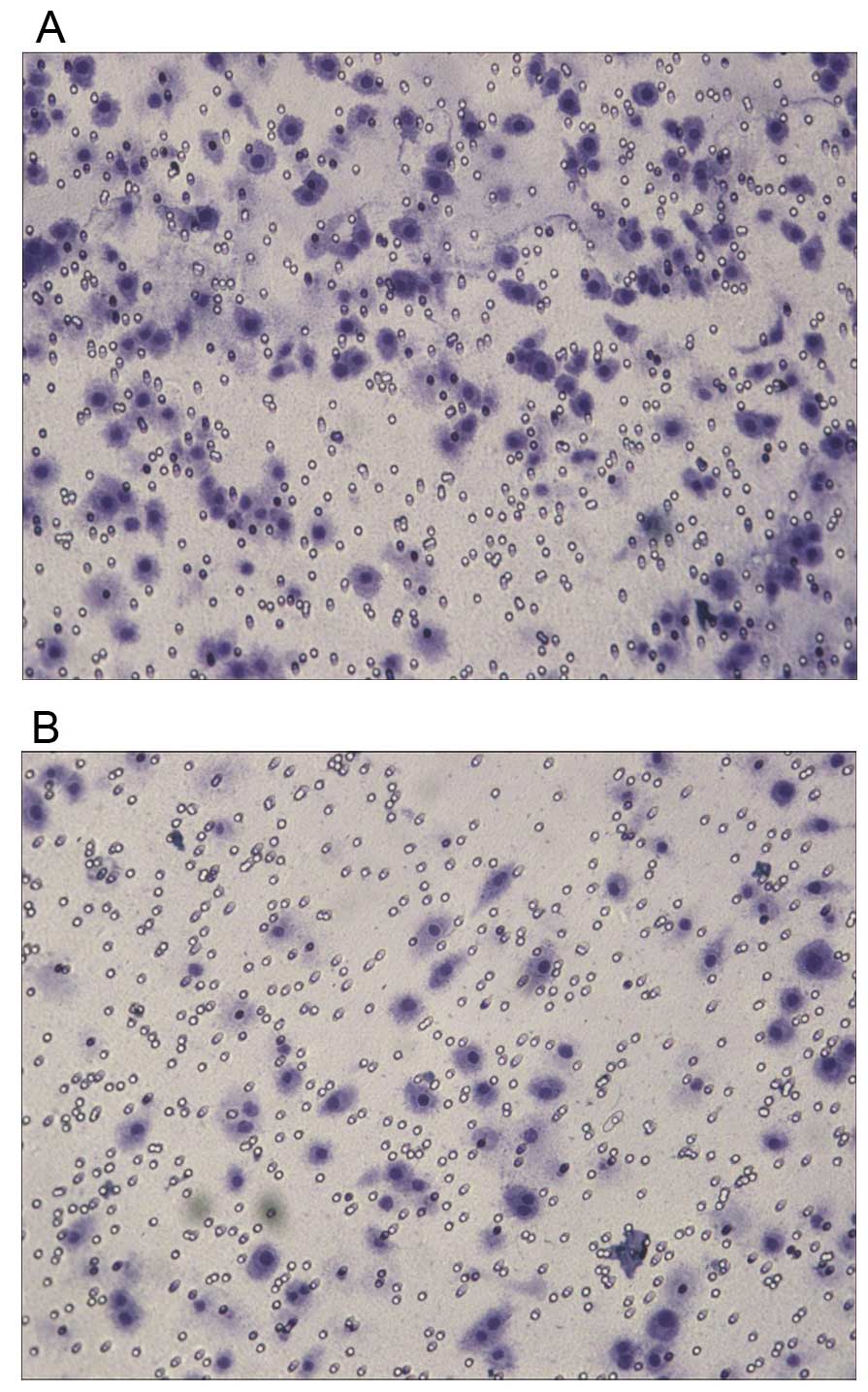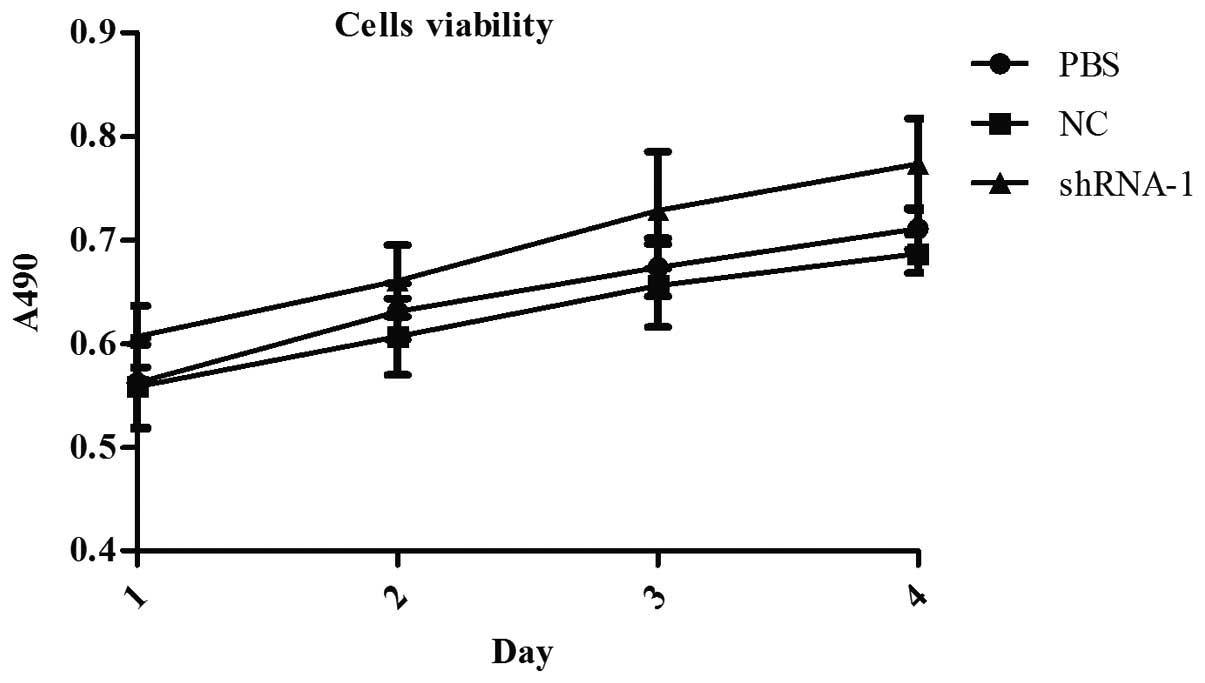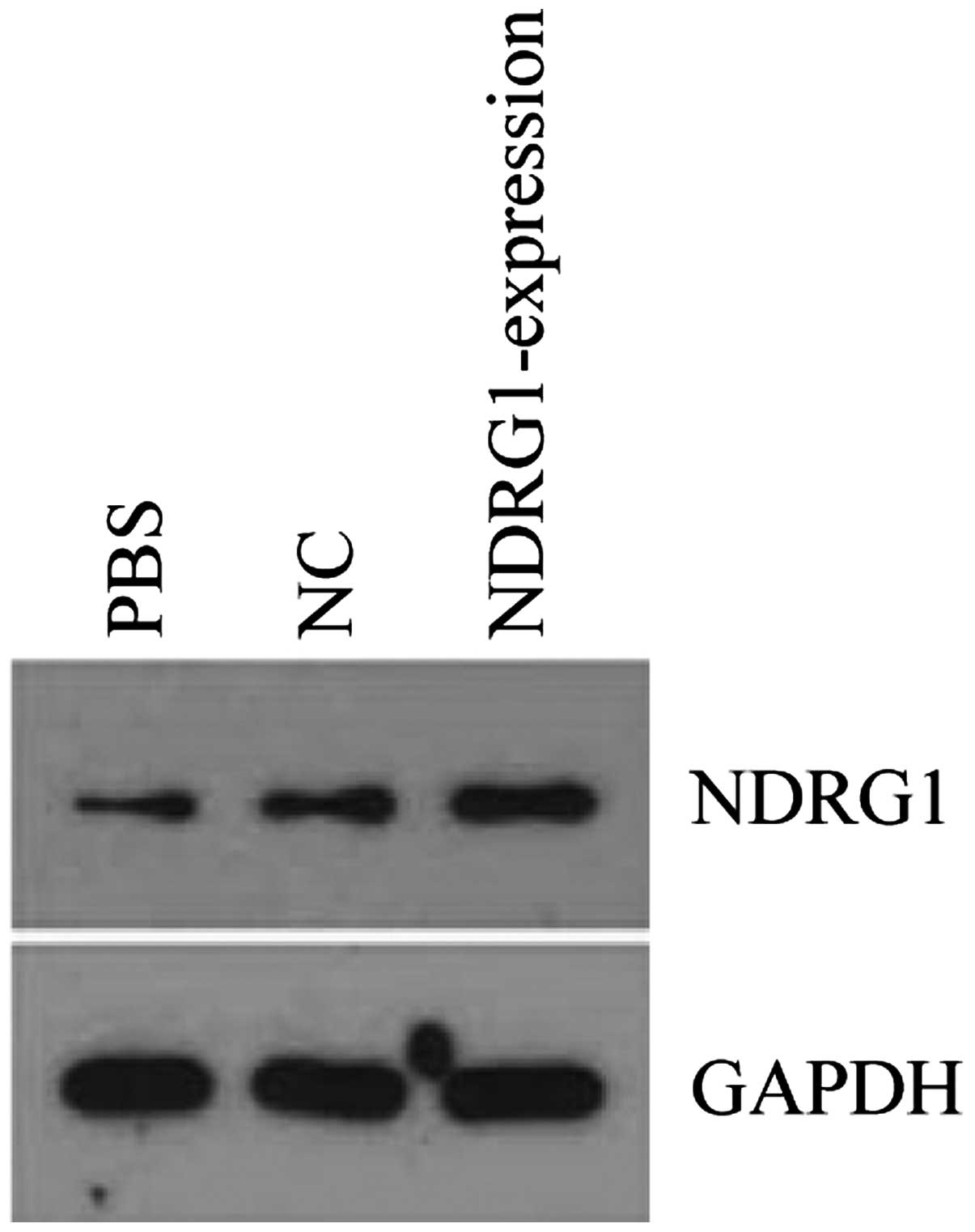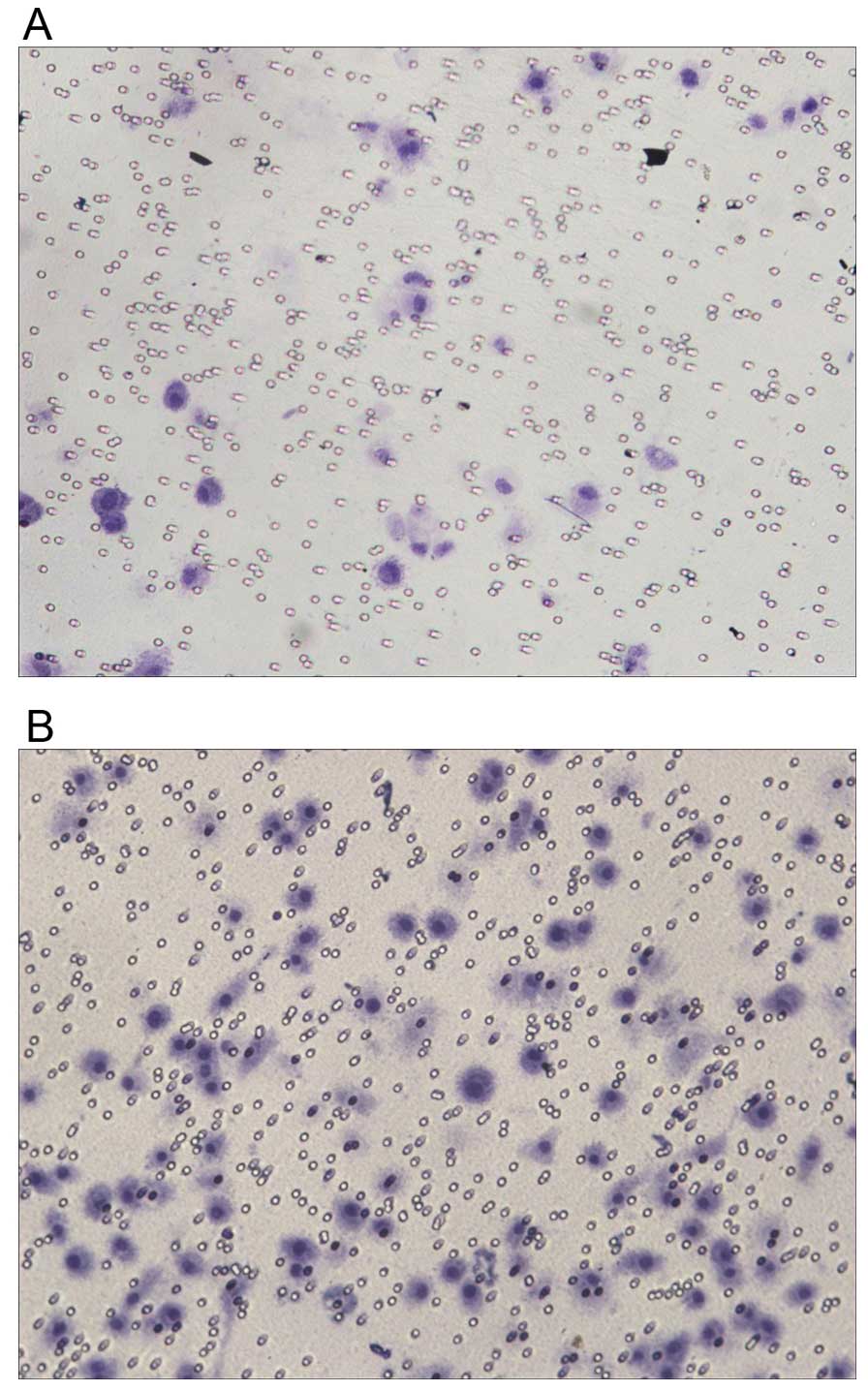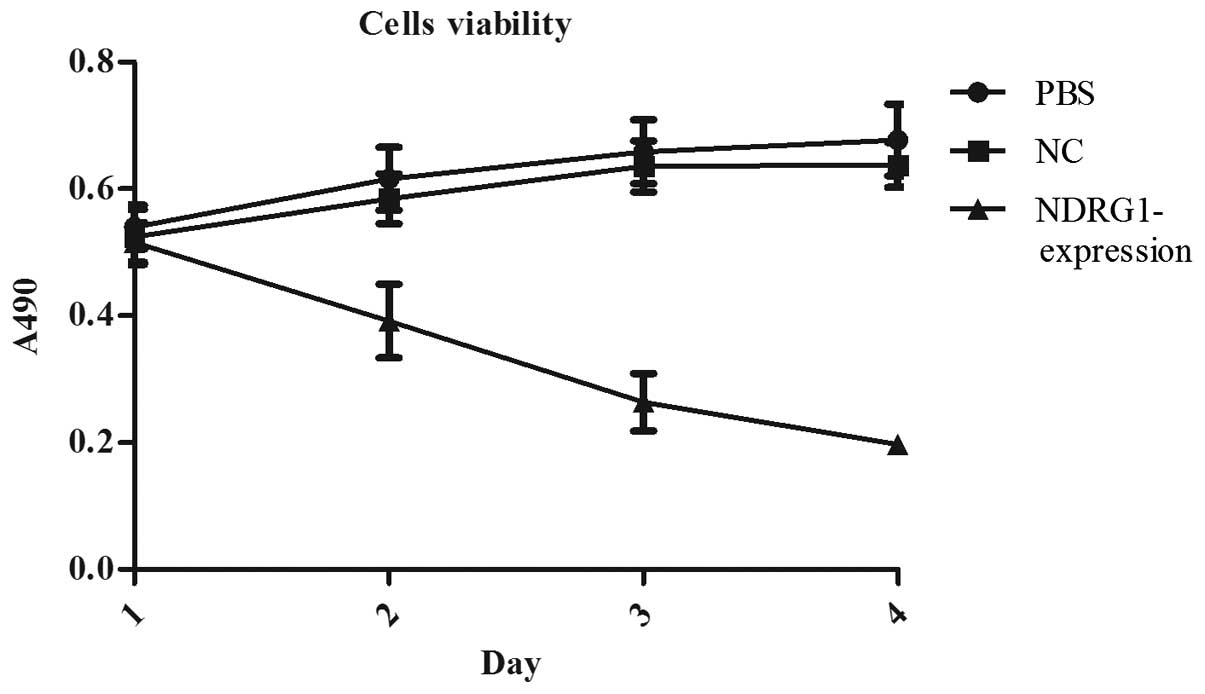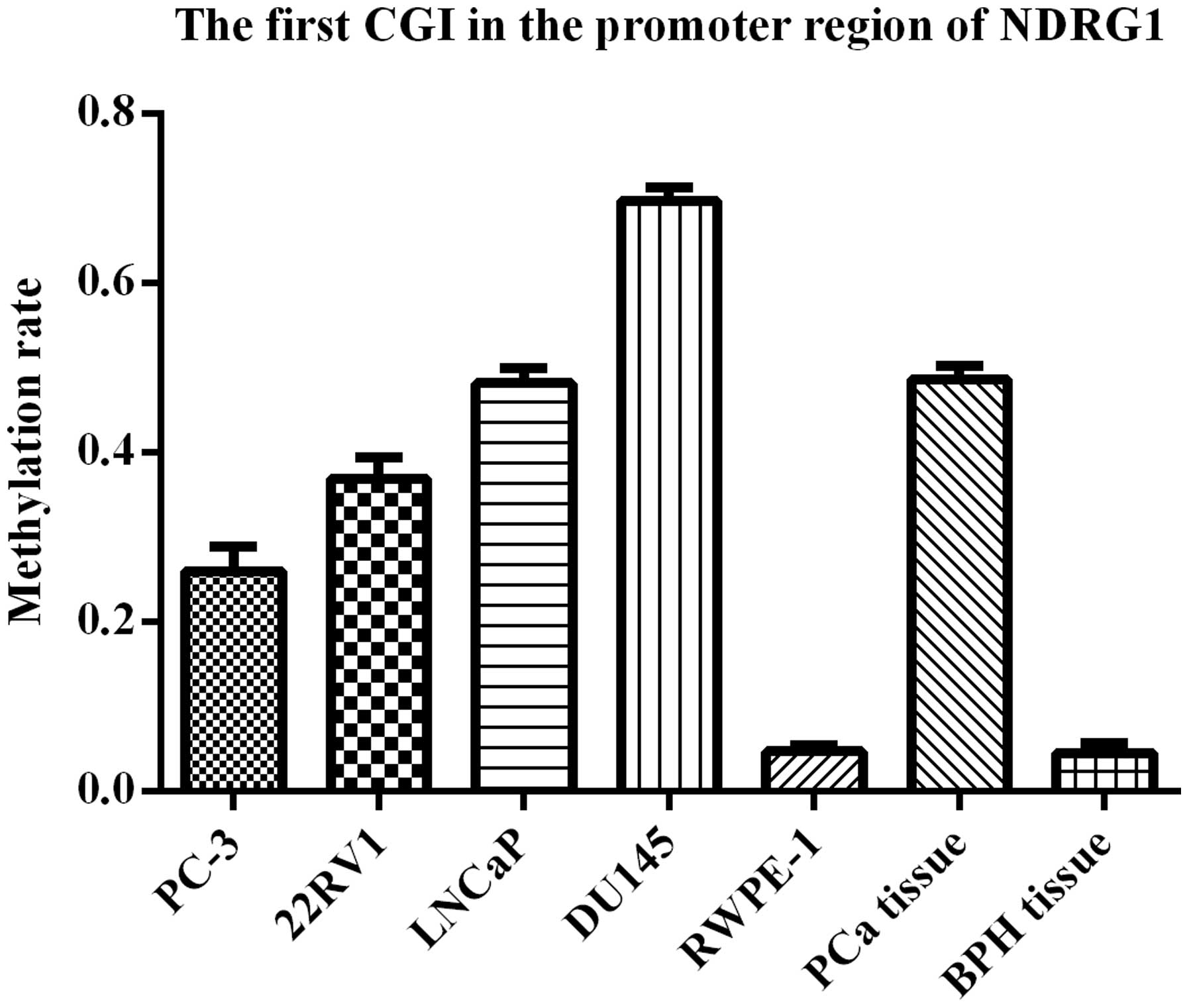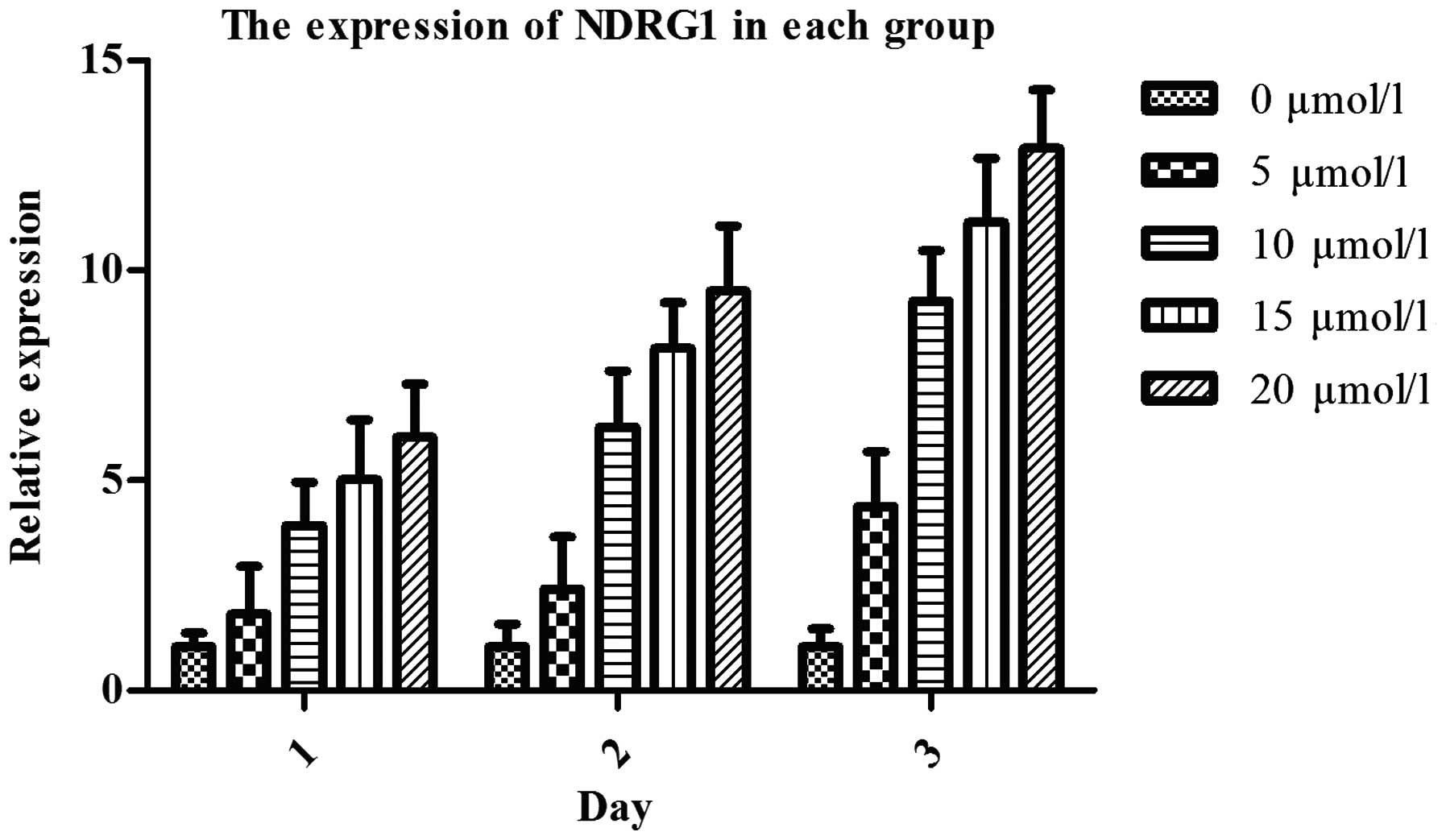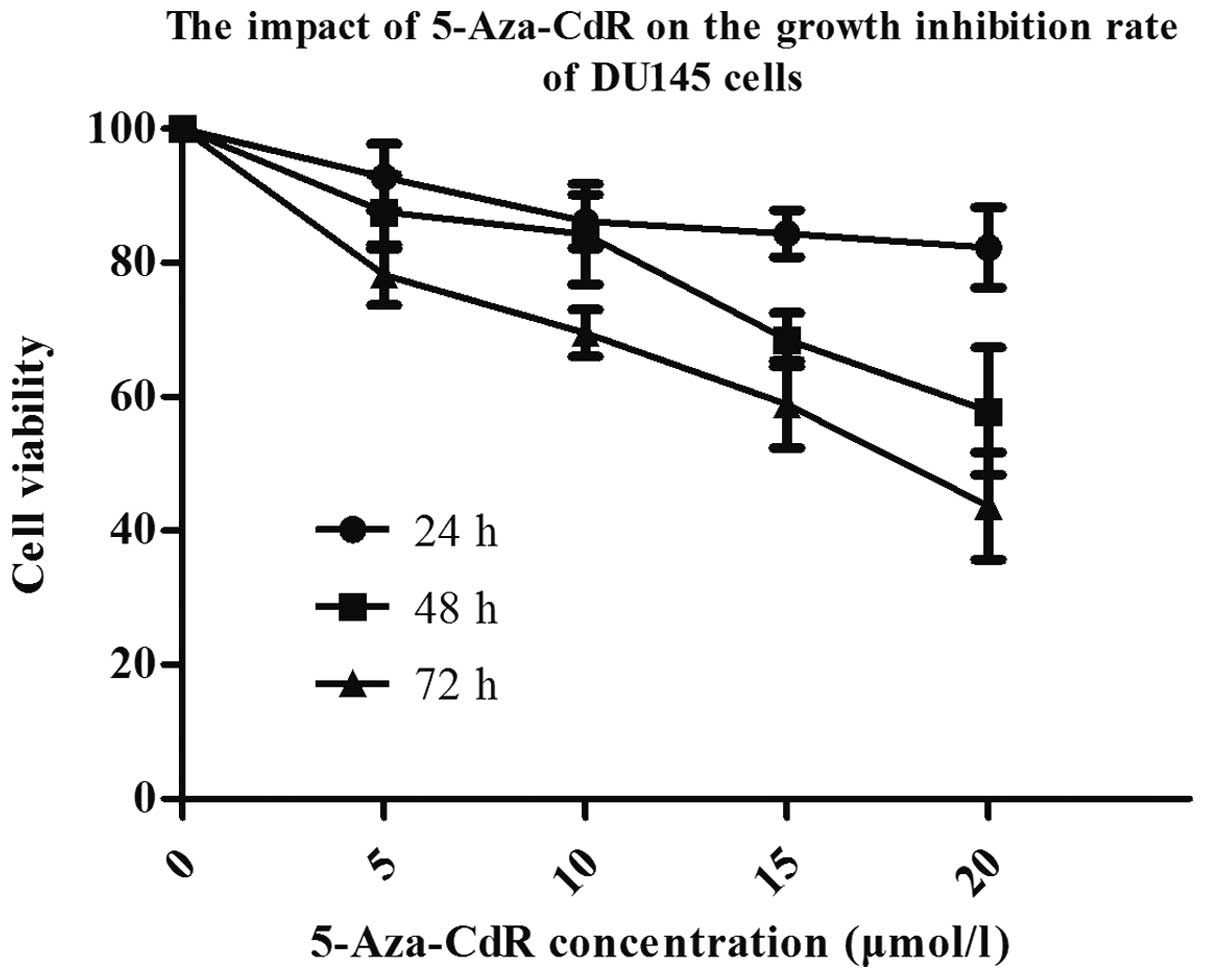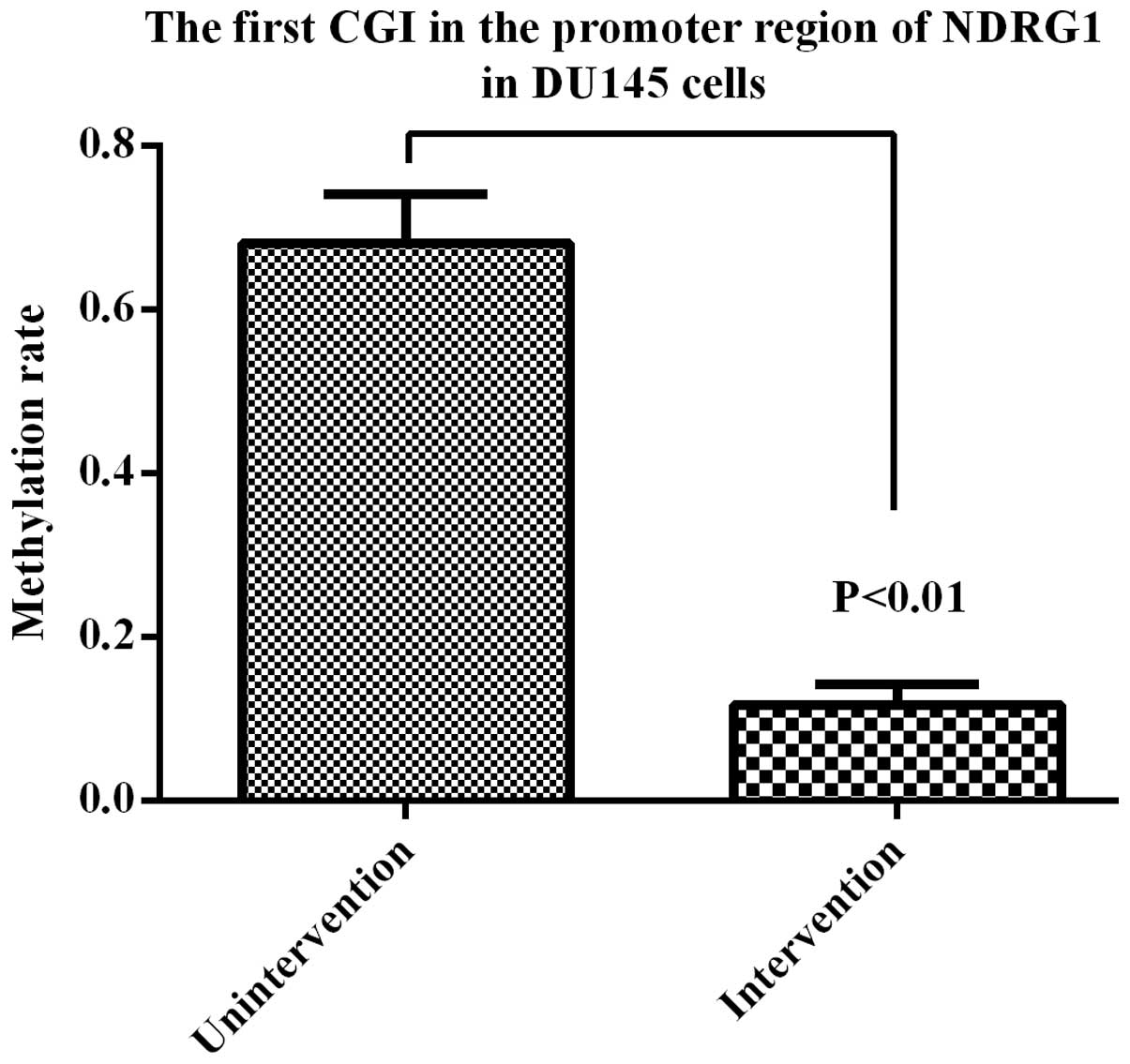Downregulation of N-myc downstream regulated gene 1 caused by the methylation of CpG islands of NDRG1 promoter promotes proliferation and invasion of prostate cancer cells
- Authors:
- Published online on: July 16, 2015 https://doi.org/10.3892/ijo.2015.3086
- Pages: 1001-1008
Abstract
Introduction
Prostate cancer (PCa) is one of the most common malignant tumors of male urinary and reproductive system. Worldwide, PCa has the second highest incidence among malignant tumors of the male. An estimated 220,800 new cases of PCa will occur in the US during 2015. The incidence of PCa has surpassed lung cancer, becoming the first health hazard of the men, accounting for 26% of all male malignancies. With an estimated 27,540 deaths in 2015, PCa is the second-leading cause of cancer death in men (1). PCa is the most frequent cancer among males in Europe. In Europe in 2015, the number of predicted PCa deaths is 72,600 (2). China is one of the nations which have a lower incidence and mortality of PCa, but the incidence shows a continued rapid growth trend in recent years. Risk factors for PCa include age, race and heredity. Moreover, many molecular biological changes which lead to alteration of gene expression and protein functions have been found, including chromosomal aberration, gene amplification and mutation. Similar to other human malignancies, PCa is also the result of genetic and epigenetic factors working together. However, for PCa, the exact molecular mechanism of tumor occurrence and progression is still not clear.
NDRG family is a group of genes which have been found in recent years, including NDRG1, NDRG2, NDRG3 and NDRG4. Researches found that NDRG1 was related to tumor cell stress, proliferation, differentiation and invasion. NDRG1 which is conserved in evolution can interact with a variety of transcription factors, acting as a transcriptional co-repressor factor. NDRG1 was originally discovered with the mouse embryonic N-myc gene knockout (3), located on human chromosome 8q 24.3, containing 16 exons and 15 introns. NDRG1 expression can be upregulated by a variety of physiological conditions or external stimulus, which could promote cell differentiation. NDRG1 has been studied in breast (4,5), pancreatic (6–8), gastric cancer (9), colon (5,10), cervical (11), kidney cancer (12) and PCa (8,13–16), but the findings are not consistent. Whether NDRG1 has a role in tumor suppression or promotion remains controversial. The role may be associated with specific tissues or tumor microenvironment. Current research tends to consider NDRG1 as a tumor suppressor gene (17) in PCa, inhibiting cell proliferation, metastasis and invasion, however, the regulation mechanism is unclear.
Studies have shown that DNA methylation may be associated with the expression level of NDRG1 in breast cancer (5). But in PCa, how the expression level of NDRG1 changes and its epigenetic regulatory mechanisms are not entirely clear. This research was conducted by a preliminary study of the expression and function of NDRG1 in PCa, and then by study of the methylation of NDRG1 promoter which could be one of the epigenetic molecular mechanisms of the changes of NDRG1 expression level.
Materials and methods
Ethics statement
The study was approved by the ethics board of the Second Hospital of Tianjin Medical University. All samples were obtained from patients who signed informed consent approving the use of their tissues for research purposes after operation.
Prostate tissue samples
All of the PCa tissues were collected after radical prostatectomy at the Department of Urology of the hospital. None of the patients had received neoadjuvant hormone therapy before the operation. Benign prostatic hyperplasia (BPH) tissues were collected after suprapubic enucleation of the prostate. Fresh prostate tissues were sampled directly after surgical removal of the gland and were immediately frozen in liquid nitrogen. A diagnostic H&E section was prepared to identify the tissues by pathologists.
Cell culture
Human PCa cell lines (LNCap, PC-3, DU145 and 22Rv1) and normal prostate epithelial cell line (RWPE-1) were obtained from the American Type Culture Collection (ATCC; Manassas, VA, USA) and maintained in our laboratory. Cells were cultured in RPMI-1640 (Gibco) supplemented with 10% fetal calf serum and penicillin (100 U/ml). Cultures were maintained under an atmosphere containing 5% CO2.
RT-qPCR
Total RNA was extracted using TRIZol reagent (Invitrogen, Carlsbad, CA, USA). cDNA was synthesized using M-MLV MicroRNA reverse transcription kit (Promega, Madison, WI, USA). RT-qPCR was performed with SYBR Premix Ex Taq™ (Takara, Biotechnology Co., Ltd., Dalian, China). PCR primer for NDRG1 was 5′-CCGACAACCA CTACCTGA-3′ (forward) and 5′-CGTGAAGAATGTGCGAG AC-3′ (reverse). The expression level were normalized to GAPDH. PCR primer for GAPDH was 5′-GGATTTGGTCG TATTGGG-3′ (forward) and 5′-GGAAGATGGTGATGGGA TT-3′ (reverse). PCR was performed under the following conditions: 94°C for 4 min, followed by 40 cycles at 94°C for 30 sec, 50°C for 30 sec and 72°C for 40 sec. Each sample was run in triplicate.
Western blot analysis
All proteins were resolved on a 10% SDS-denatured polyacrylamide gel and were then transferred onto a nitrocellulose membrane. Membranes were incubated with blocking buffer for 60 min at room temperature and then incubated with primary antibody overnight at 4°C. The membranes were washed and incubated with a horseradish peroxidase (HRP)-conjugated secondary antibody. Protein expression was assessed by enhanced chemiluminescence and exposure to chemiluminescent film. The LabWorks image acquisition and analysis software (UVP, LLC Upland, CA, USA) was used to quantify band intensities. All antibodies were purchased from Tianjin Saier Biotechnology Co., Ltd. (Tianjin, China).
Immunohistochemistry staining (IHC)
Paraffin-embedded sections (4 μm) were deparaffinized and hydrated in xylene, followed by graded alcohols to water. Antigen retrieval was performed twice in 0.01 M citrate 10 min in a microwave oven, followed by a 60-min cool down. Slides were then incubated with various primary antibodies followed by EnVision-plus-labeled polymer-conjugated horseradish peroxidase and DAB monitoring staining (Beijing Zhongshan Golden Bridge Biotechnology Co., Ltd., Beijing). Then, slides were counter-stained and dehydrated for viewing and imaging. The antibody was anti-NDRG1 (GeneTech, Shanghai, China).
Plasmid vector construction and cell transfection
Two types of plasmid vectors were constructed for changing the expression level of NDRG1. PC-3 cells were divided into several groups as follows according to different transfection contents: i) for downregulation: a, PBS; b, pRNAT-U6.1/Neo (NC); c, PSiHIV-U6/shRNA-1; d, PSiHIV-U6/shRNA-2; e, PSiHIV-U6/shRNA-3; f, PSiHIV-U6/shRNA-4; ii) for upregulation: a, PBS; b, pReceiver-Lv103 (NC); c, pReceiver-Lv103-Expression. PC-3 cells were seeded in triplicate in 96-well plates, allowed to settle for 24 h and then co-transfected with different contents by using Lipofectamine 2000 (Invitrogen). After the transfection, using light microscope the growth of the cells was observed.
MTT assay
PC-3 cells were plated on 96-well plates at 1×104 cells/well. Viable cells were measured on day 1, 2, 3 and 4 after plating. After incubation with 3-(4,5-Dimethylthiazol-2-yl)-2,5-diphenyltetrazolium bromide (MTT), the cells were lysed in 150 ml of 100% dimethylsulfoxide (DMSO) and UV-visible absorbance was read at 490 nm. Each sample was run in triplicate.
Flow cytometry
PC-3 cells were collected and fixed with 70% ethanol for the detection of early apoptosis. The dyeing of cells was performed according to the instructions of Annexin V-R-PE cell apoptosis detection kit (SouthernBiotech, Birmingham, AL USA). Flow cytometry (BD Biosciences, San Jose, CA, USA) was used to detect the percentage of early apoptosis. The measurement was performed in triplicate.
Transwell migration assay
PC-3 cells were collected. PC-3 (5×104) cells were placed on the upper chamber of each insert coated with 50 ml of 2 mg/ml Matrigel (growth factor reduced BD Matrigel™ matrix), and 600 ml of RPMI-1640 with 20% FBS was added to the lower part of the chamber. After incubating for 24 h, the chambers were disassembled, and the membranes were stained with a 2% crystal violet solution for 15 min and placed on a glass slide. Then, cells that had migrated across the membrane were counted in five random visual fields using a microplate reader at 490 nm. All assays were performed three independent times in triplicate.
Bisulfite sequencing PCR (BSP) primer design
NDRG1 promoter was predicted by NCBI (www.ncbi.nlm.nih.gov/gene) and Prosean (www-bimas.cit.nih.gov/molbio/Proscan/). BSP Primer was designed by Promoter 2.0 (www.cbs.dtu.dk/services/Promoter/), BLAST (www.ncbi.nlm.nih.gov/BLAST/), methBLAST (medgen.ugent.be/methBLAST/) and MethPrimer (www.urogene.org/methprimer/).
BSP
After genomic DNA treatment by bisulfite, all of the unmethylated cytosines were converted to uracils, whereas methylated cytosines were unchanged. BSP primers were designed for PCR. Purified products were used for TA cloning. Positive clones were selected from each of the TA clones. The methylation site changes in CGIs of NDRG1 promoter were observed by comparing with the original gene sequences (DNAMAN V6).
Statistical analysis
The data are presented as mean ± standard deviation (± SD). The two-tailed Student's t-test was used to evaluate the significance of the differences between two groups. P<0.05 was considered significant.
Results
NDRG1 expression in normal prostate and PCa
IHC showed that NDRG1 protein expressed both in the cytoplasm and nucleus, but mainly in the cytoplasm (Fig. 1). NDRG1 expression in RWPE-1 cells was higher than that in PC-3 and LNCap cells. NDRG1 expression in PCa tissues was lower than that in BPH tissues (Fig. 2). RT-qPCR showed that NDRG1 mRNA expression was higher in RWPE-1 cells than that in LNCap and PC-3 cells (Fig. 3). Western blot analysis showed that NDRG1 protein expression in RWPE-1 cells was higher than that in LNCap and PC-3 cells (Fig. 4).
NDRG1 expression is changed by transfection with plasmid vectors
After PC-3 cell transfection with PSiHIV-U6/shRNA, NDRG1 expression was downregulated. RT-qPCR showed that NDRG1 mRNA expression was significantly decreased, and PSiHIV-U6/shRNA-1 had the most preferably interference effect (Fig. 5). Western blot analysis showed that NDRG1 protein expression was significantly decreased, and PSiHIV-U6/shRNA-1 had the most preferably interference effect (Fig. 6). PSiHIV-U6/shRNA-1 was chosen for the following experiments. Transwell assay showed that after the transfection, the invasive ability of PC-3 cells was significantly increased (Table I), suggesting that downregulation of NDRG1 expression had a significant enhancing effect on the migration of PC-3 cells (Fig. 7). Flow cytometry showed that PSiHIV-U6/shRNA-1 group had the lowest early apoptosis rate at 0.02%. NC group had the highest early apoptosis rate at 1.34% and PBS group was 1.94%. MTT assay showed that the cell proliferation rate of PSiHIV-U6/shRNA-1 group was significantly higher than the others (Fig. 8). After transfection for 24, 48, 72 and 96 h, the number of cells in PSiHIV-U6/shRNA-1 group was always significantly higher than the other groups (P<0.01). Howecer, at each time-point, the difference between PBS group and NC group was no statistically significant (P>0.05).
After PC-3 cell transfection with pReceiver-Lv103-Expression, NDRG1 expression was upregulated. Western blot analysis showed that NDRG1 protein expression was higher in pReceiver-Lv103-expression group than that in control group (Fig. 9). Transwell assay showed that after the transfection, the invasive ability of PC-3 cells was significantly decreased (Table II), suggesting that upregulation of NDRG1 expression did have a significant weakening effect on the migration of PC-3 cells (Fig. 10). Flow cytometry showed that pReceiver-Lv103-Expression group had the highest early apoptosis rate at 26.48%. NC group had the lowest early apoptosis rate at 0.64% and PBS group was 4.97%. MTT assay showed that the cell proliferation rate of pReceiver-Lv103-Expression group was significantly lower than the others (Fig. 11). After transfection for 24, 48, 72 and 96 h, the number of cells in pReceiver-Lv103-Expression group was always significantly lower than the other groups (P<0.01). At each time-point, the difference between PBS group and NC group was no statistically significant (P>0.05).
The methylation status of NDRG1 promoter in prostate cells
There are four CGIs which may occur aberrant methylation in the promoter region of human NDRG1 from −3000 bp to +70 bp. The present study analyzed the first CGI from −213 bp to +78 bp, containing 21 CpG sites (Table III). With BSP primer for NDRG1 promoter, using PCR amplified bisulfite modified DNA. The molecular weight of PCR products were close to 291 bp. The rate of methylation of the first CGI was analyzed in different samples by BIQ Analyzer (Fig. 12). The results were 24.8% (PC-3 cells), 36.2% (22RV1 cells), 48.6% (LNCap cells), 69.5% (DU145 cells), 4.8% (RWPE-1 cells), 48.6% (PCa tissues) and 4.3% (BPH tissues). The rate of methylation in PCa cells or tissues was significantly higher than that in normal prostate cells or tissues (P<0.01). DU145 cells which had the highest rate of methylation were chosen for the following experiments. In PCa, the CpG site which was most likely to occur aberrant methylation was the seventeenth CpG site (−127 bp) from the 5′ end. Approximately 50% of methylation occurred at this site.
NDRG1 is demethylated by 5-Aza-CdR in DU145 cells
RT-qPCR showed that after treatment with 5-Aza-CdR for 24, 48 and 72 h, NDRG1 mRNA expression in DU145 cells was significantly upregulated (P<0.05), dose-dependently (Fig. 13). MTT assay showed that after treatment with different concentrations of 5-Aza-CdR, the density of cells was significantly reduced, and cells appeared shrunken and non-viable. The inhibiting effect was dose-dependent (Fig. 14). After 72 h, the methylation rate of the first CGI located in the promoter region of NDRG1 was 11.4%, which was significant at <69.5% (Fig. 15). The results showed that 5-Aza-CdR was able to reverse the methylation status of NDRG1 promoter in DU145 cells.
Discussion
In the present study, we studied NDRG1 expression in prostate tissues and cells. NDRG1 protein expressed in both the cytoplasm and nucleus but mainly in the cytoplasm. NDRG1 expression in PC-3 and LNCap cells was lower than that in RWPE-1 cells. With these results, we confirmed that NDRG1 was associated with PCa.
For further research, we designed two types of plasmid vectors, changing the expression level of NDRG1 in PC-3 cells. After downregulation of NDRG1 expression, the cell invasive ability and proliferation rate in the experimental group was significantly increased. The rate of early apoptosis significantly decreased. After upregulation of NDRG1 expression, the cell invasive ability and proliferation rate in the experimental group was significantly decreased. The rate of early apoptosis significantly increased. We can conclude that NDRG1 expression in PCa is lower than that in normal prostate, and NDRG1 may have an inhibitory effect on the progression and metastasis of PCa. NDRG1 is the downstream gene of p53 and may cooperate with p53, promoting cell differentiation, maturation and apoptosis (18). Upregulation of NDRG1 reduced the expression of vascular endothelial growth factor (VEGF) and interleukin-8, inhibiting tumor angiogenesis and metastasis (19). Moreover, it can change the adhesion between tumor cells, inhibiting the extracellular matrix degradation. NDRG1 expression was negatively correlated with the activity of matrix metalloproteinase MMP-9, inhibiting the extracellular matrix degradation and tumor metastasis (17).
Epigenetic (20) changes are early molecular events occurring in the transcription of tumor cells. DNA methylation is a common epigenetic change, mostly occurring at 5′-CpG-3′ dinucleotide. The density of CpG sequence is high in the genome regions named CGIs (21). CGIs usually locate in the gene promoter region and may extend to the exon. The methylation of CGIs was able to silence gene expression. In the human genome, the CpG sites are usually methylated out of CGIs but stay unmethylated in CGIs. This methylation pattern can be stably maintained during cell division (22). Therefore, the methylation of CGIs plays an important role in tumor cell proliferation, DNA repair, cell cycle regulation and apoptosis (23–25). DNA methylation may prevent the combination of specific transcription factors and promoter recognition, inhibiting gene expression. Kalaydjieva et al (26) found a CGI located at the 5′ end of NDRG1 and considered that NDRG1 expression may be regulated by DNA methylation. Guan et al (27) reported that NDRG1 expression was regulated through multiple mechanisms, including DNA methylation (27). Han et al (4) found the high methylation rate of NDRG1 promoter in DNA promoter region was related to the occurrence and progression of breast cancer. Chang et al (9) reported that the methylation of DNA promoter may be related to the occurrence and progression of gastric cancer. Gravina et al (28) found that increased levels of DNA methyltransferases (DNMT) are associated with the tumorigenic capacity of PCa cells. Gillio-Tos et al (29) reported that the DNMT3b may play an important role in PCa progression. Therefore, we speculated that the low expression of NDRG1 in PCa may be related to the methylation status of CGIs in gene promoter region. Then, we analyzed the methylation rate of the first CGI located in the promoter region of NDRG1 in prostate cells and tissues. The results showed that the methylation rate in PCa was higher than that in BPH, which could explain the abnormal expression of NDRG1. Our research suggested that the high methylation rate of NDRG1 promoted the occurrence and progression of PCa.
Next, we treated DU145 cells with 5-Aza-CdR, reducing the methylation levels of NDRG1 and observed changes in cell biological behavior. The expression level and methylation rate of NDRG1 was significantly increased. The survival rate of DU145 cells was significantly decreased. Thus, we conclude that DNA methylation silenced NDRG1 expression.
In conclusion, the key finding of this study is that the low expression of NDRG1 can increase the proliferation and invasion of PCa cells. Methylation of CGIs in the NDRG1 promoter may be one of the reasons which lead to the low expression of NDRG1. This result indicates that the methylation of NDRG1 promoter plays an essential role in regulating the proliferation and invasion of PCa cells. NDRG1 may serve as a novel therapeutic target for the treatment of PCa.
Acknowledgements
The present study was supported by grants from the Key Project of Tianjin Municipal Science and Technology Commission (no. 15JCZDJC35900), the Tianjin Municipal Education Commission (no. 20140122) and the Key Project of Tianjin Health Bureau (no. 13KG141).
References
|
Siegel RL, Miller KD and Jemal A: Cancer statistics, 2015. CA Cancer J Clin. 65:5–29. 2015. View Article : Google Scholar : PubMed/NCBI | |
|
Malvezzi M, Bertuccio P, Rosso T, Rota M, Levi F, La Vecchia C and Negri E: European cancer mortality predictions for the year 2015: Does lung cancer have the highest death rate in EU women? Ann Oncol. 26:779–786. 2015. View Article : Google Scholar : PubMed/NCBI | |
|
Okuda T and Kondoh H: Identification of new genes ndr2 and ndr3 which are related to Ndr1/RTP/Drg1 but show distinct tissue specificity and response to N-myc. Biochem Biophys Res Commun. 266:208–215. 1999. View Article : Google Scholar : PubMed/NCBI | |
|
Han LL, Hou L, Zhou MJ, Ma ZL, Lin DL, Wu L and Ge YL: Aberrant NDRG1 methylation associated with its decreased expression and clinicopathological significance in breast cancer. J Biomed Sci. 20:522013. View Article : Google Scholar : PubMed/NCBI | |
|
Kovacevic Z, Fu D and Richardson DR: The iron-regulated metastasis suppressor, Ndrg-1: Identification of novel molecular targets. Biochim Biophys Acta. 1783:1981–1992. 2008. View Article : Google Scholar : PubMed/NCBI | |
|
Angst E, Dawson DW, Nguyen A, Park J, Go VL, Reber HA, Hines OJ and Eibl G: Epigenetic regulation affects N-myc downstream-regulated gene 1 expression indirectly in pancreatic cancer cells. Pancreas. 39:675–679. 2010. View Article : Google Scholar : PubMed/NCBI | |
|
Kim-Fuchs C, Winterhalder S, Winter A, Malinka T, Born D, Schäfer S, Stroka D, Gloor B, Candinas D and Angst E: The silencing of N-myc downstream-regulated gene-1 in an orthotopic pancreatic cancer model leads to more aggressive tumor growth and metastases. Dig Surg. 31:135–142. 2014. View Article : Google Scholar : PubMed/NCBI | |
|
Youns M and Fathy GM: Upregulation of extrinsic apoptotic pathway in curcumin-mediated antiproliferative effect on human pancreatic carcinogenesis. J Cell Biochem. 114:2654–2665. 2013. View Article : Google Scholar : PubMed/NCBI | |
|
Chang X, Zhang S, Ma J, Li Z, Zhi Y, Chen J, Lu Y and Dai D: Association of NDRG1 gene promoter methylation with reduced NDRG1 expression in gastric cancer cells and tissue specimens. Cell Biochem Biophys. 66:93–101. 2013. View Article : Google Scholar | |
|
Li Q and Chen H: Transcriptional silencing of N-Myc downstream-regulated gene 1 (NDRG1) in metastatic colon cancer cell line SW620. Clin Exp Metastasis. 28:127–135. 2011. View Article : Google Scholar | |
|
Geng XX, Quan LN, Ma R and Tang LP: Effects of As2O3 and all-trans retinoic acid on the growth of HeLa cell line and their relation with gene NDRG1. Zhonghua Zhong Liu Za Zhi. 33:8–12. 2011.(In Chinese). PubMed/NCBI | |
|
Hosoya N, Sakumoto M, Nakamura Y, Narisawa T, Bilim V, Motoyama T, Tomita Y and Kondo T: Proteomics identified nuclear N-myc downstream-regulated gene 1 as a prognostic tissue biomarker candidate in renal cell carcinoma. Biochim Biophys Acta. 1834:2630–2639. 2013. View Article : Google Scholar : PubMed/NCBI | |
|
Dixon KM, Lui GY, Kovacevic Z, Zhang D, Yao M, Chen Z, Dong Q, Assinder SJ and Richardson DR: Dp44mT targets the AKT, TGF-β and ERK pathways via the metastasis suppressor NDRG1 in normal prostate epithelial cells and prostate cancer cells. Br J Cancer. 108:409–419. 2013. View Article : Google Scholar : PubMed/NCBI | |
|
Liu W, Iiizumi-Gairani M, Okuda H, Kobayashi A, Watabe M, Pai SK, Pandey PR, Xing F, Fukuda K, Modur V, et al: KAI1 gene is engaged in NDRG1 gene-mediated metastasis suppression through the ATF3-NFkappaB complex in human prostate cancer. J Biol Chem. 286:18949–18959. 2011. View Article : Google Scholar : PubMed/NCBI | |
|
Ghalayini MK, Dong Q, Richardson DR and Assinder SJ: Proteolytic cleavage and truncation of NDRG1 in human prostate cancer cells, but not normal prostate epithelial cells. Biosci Rep. 33:332013. View Article : Google Scholar | |
|
Symes AJ, Eilertsen M, Millar M, Nariculam J, Freeman A, Notara M, Feneley MR, Patel HR, Masters JR and Ahmed A: Quantitative analysis of BTF3, HINT1, NDRG1 and ODC1 protein over-expression in human prostate cancer tissue. PLoS One. 8:e842952013. View Article : Google Scholar | |
|
Lee JC, Chung LC, Chen YJ, Feng TH and Juang HH: N-myc downstream-regulated gene 1 downregulates cell proliferation, invasiveness, and tumorigenesis in human oral squamous cell carcinoma. Cancer Lett. 355:242–252. 2014. View Article : Google Scholar : PubMed/NCBI | |
|
Kovacevic Z, Sivagurunathan S, Mangs H, Chikhani S, Zhang D and Richardson DR: The metastasis suppressor, N-myc downstream regulated gene 1 (NDRG1), upregulates p21 via p53-independent mechanisms. Carcinogenesis. 32:732–740. 2011. View Article : Google Scholar : PubMed/NCBI | |
|
Hosoi F, Izumi H, Kawahara A, Murakami Y, Kinoshita H, Kage M, Nishio K, Kohno K, Kuwano M and Ono M: N-myc downstream regulated gene 1/Cap43 suppresses tumor growth and angiogenesis of pancreatic cancer through attenuation of inhibitor of kappaB kinase beta expression. Cancer Res. 69:4983–4991. 2009. View Article : Google Scholar : PubMed/NCBI | |
|
Holliday R: The inheritance of epigenetic defects. Science. 238:163–170. 1987. View Article : Google Scholar : PubMed/NCBI | |
|
Ushijima T: Detection and interpretation of altered methylation patterns in cancer cells. Nat Rev Cancer. 5:223–231. 2005. View Article : Google Scholar : PubMed/NCBI | |
|
Cottrell SE: Molecular diagnostic applications of DNA methylation technology. Clin Biochem. 37:595–604. 2004. View Article : Google Scholar : PubMed/NCBI | |
|
Esteller M, Corn PG, Baylin SB and Herman JG: A gene hypermethylation profile of human cancer. Cancer Res. 61:3225–3229. 2001.PubMed/NCBI | |
|
Yang B, Guo M, Herman JG and Clark DP: Aberrant promoter methylation profiles of tumor suppressor genes in hepatocellular carcinoma. Am J Pathol. 163:1101–1107. 2003. View Article : Google Scholar : PubMed/NCBI | |
|
Edamoto Y, Hara A, Biernat W, Terracciano L, Cathomas G, Riehle HM, Matsuda M, Fujii H, Scoazec JY and Ohgaki H: Alterations of RB1, p53 and Wnt pathways in hepatocellular carcinomas associated with hepatitis C, hepatitis B and alcoholic liver cirrhosis. Int J Cancer. 106:334–341. 2003. View Article : Google Scholar : PubMed/NCBI | |
|
Kalaydjieva L, Gresham D, Gooding R, Heather L, Baas F, de Jonge R, Blechschmidt K, Angelicheva D, Chandler D, Worsley P, et al: N-myc downstream-regulated gene 1 is mutated in hereditary motor and sensory neuropathy-Lom. Am J Hum Genet. 67:47–58. 2000. View Article : Google Scholar : PubMed/NCBI | |
|
Guan RJ, Ford HL, Fu Y, Li Y, Shaw LM and Pardee AB: Drg-1 as a differentiation-related, putative metastatic suppressor gene in human colon cancer. Cancer Res. 60:749–755. 2000.PubMed/NCBI | |
|
Gravina GL, Ranieri G, Muzi P, Marampon F, Mancini A, Di Pasquale B, Di Clemente L, Dolo V, D'Alessandro AM and Festuccia C: Increased levels of DNA methyltransferases are associated with the tumorigenic capacity of prostate cancer cells. Oncol Rep. 29:1189–1195. 2013. | |
|
Gillio-Tos A, Fiano V, Zugna D, Vizzini L, Pearce N, Delsedime L, Merletti F and Richiardi L: DNA methyltransferase 3b (DNMT3b), tumor tissue DNA methylation, Gleason score, and prostate cancer mortality: Investigating causal relationships. Cancer Causes Control. 23:1549–1555. 2012. View Article : Google Scholar : PubMed/NCBI |




